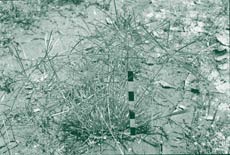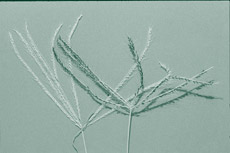
Chloris truncata (Windmill grass)
Description

Chloris truncata is a tussocky biennial or short-lived (2–3 years) perennial which grows in summer, relying on effective spring and summer rainfall for both vegetative and reproductive growth.
C. truncata is generally considered a good colonising species.
Morphology
C. truncata plants are usually 10 to 50 cm high, often stoloniferous forming a dense low crown occasionally with short branched stolons. The stems are kneed at the base, flattened, usually unbranched and smooth with 2–3 nodes. The tip of the leaf is obtuse and keeled/boat shaped with the ligule (Ligule - a membrane or hairs found on the inner (adaxial) surface of the leaf-blade/sheath junction) minutely ciliate. Inflorescences (Inflorescence - a group of flowers borne on a stem) consist of approximately 6–9 spikes radiating horizontally from a common point at the end of the stem. The spikes (Spike - an inflorescence with spikelets attached to the axis with no stalks. In grasses, lateral branches may be termed spikes) are long and hairy at the base with rigid spikelets (Spikelet - consists of one or more florets and is the basic unit of the inflorescence in grasses) arranged alternatively in rows on the underside. Spikelets are black when mature and the grain is ovoid in shape (1.5 mm long).

Distribution
C. truncata is found in temperate mainland Australia extending to central Australia, but is absent from the Northern Territory. It is associated with dryland grasslands and woodlands on most soil types, ranging from grey cracking clays to light sandy soils.
Vegetation associations
C. truncata can occur as subdominant or dominant in grasslands depending on the time of the year and is widespread throughout south eastern Australia. In relatively unchanged grasslands, it may be associated with Austrodanthonia caespitosa and Enteropogon acicularis.
Harvesting
Time
Harvesting time in eastern Australia is generally restricted to summer and early autumn, although flowering has been reported in spring and late autumn. In central western New South Wales, however, seed can be harvested following good summer rains. On ripening, spikelets turn black and seed easily shatters. An abscission (Abscission - natural shedding of dispersal units or other plant parts) layer forms at the base of each flowering stem which may break off and blow along the ground, scattering seeds as it moves. The collection of these detached seed heads is one method of harvesting the seed, although the yields may be quite low. Seed quality appears to be highest when seed is harvested in the early summer.
Methods
To date hand, vacuum and machine brush harvesting has been successful.
Seed storage
Germination percentages of seeds stored at ambient temperatures in a dry environment fall after 30 months. Others studies have suggested a reduction in germination after 12 months. A characteristic germination percentage for seed harvested from wild stands ranges between 30–40%.
Sowing
Ideal Conditions
Light appears to assist germination suggesting that surface sowings are ideal. Seeds should be sown at approximately 25 mm for good establishment and no deeper than 35 mm.
In central western New South Wales, seed should be sown in spring (early October) to utilise available moisture. C. truncata is susceptible to frosts and sowing dates must be selected with this in mind. The seed has been known to exhibit hydropedesis (induced dormancy due to low levels of soil water) which is an important factor if sowing into relatively dry soil.
Methods
Broadcasting seed onto the surface, or using the crocodile planter has resulted in some success.
Management
Applications of phosphate (50 kg/ha) and sulfur (10 kg/ha) can significantly increase seed yield.
Other species
- Astrebla lappacea (Curly Mitchell grass)
- Astrebla pectinata (Barley Mitchell grass)
- Austrodanthonia bipartita (Wallaby grass)
- Austrodanthonia caespitosa (White top)
- Austrodanthonia richardsonii (Wallaby grass)
- Bothriochloa macra (Red grass)
- Dichanthium sericeum (Queensland bluegrass)
- Elymus scaber (Common wheat grass)
- Heteropogon contortus (Black speargrass)
- Microlaena stipoides (Microlaena or Weeping grass)
- Paspalidium constrictum (Box grass)
- Paspalidium jubiflorum (Warrego summer grass)
- Themeda triandra (Kangaroo grass)

